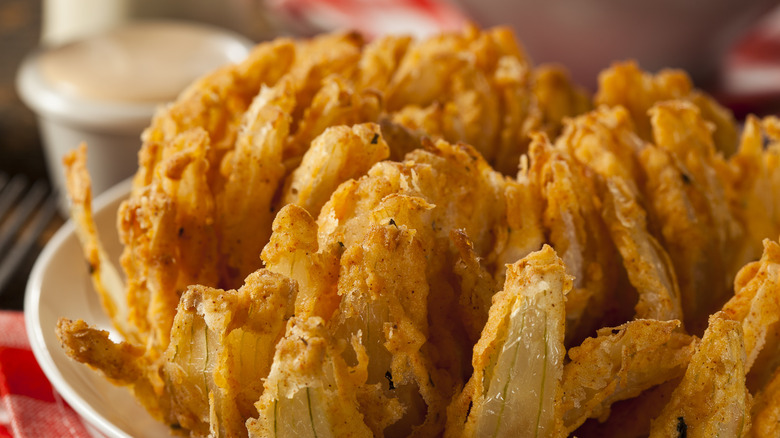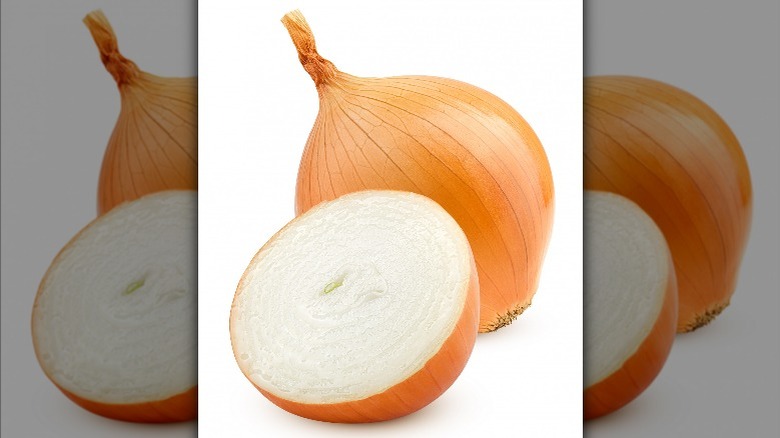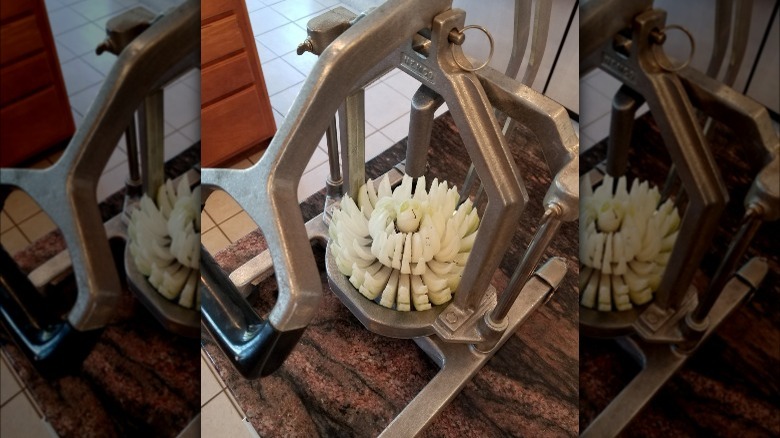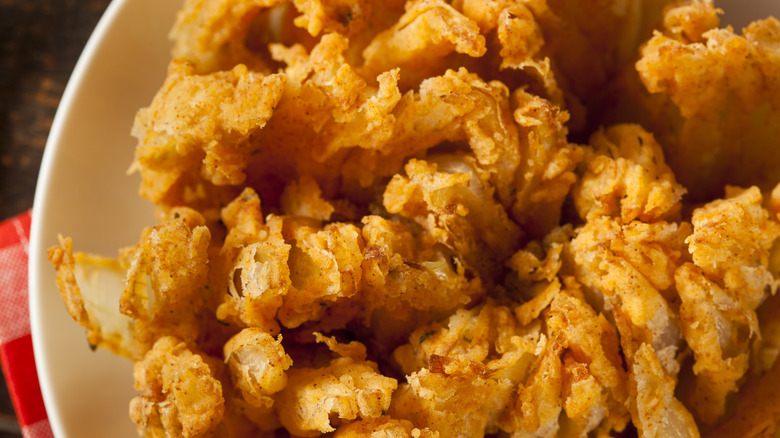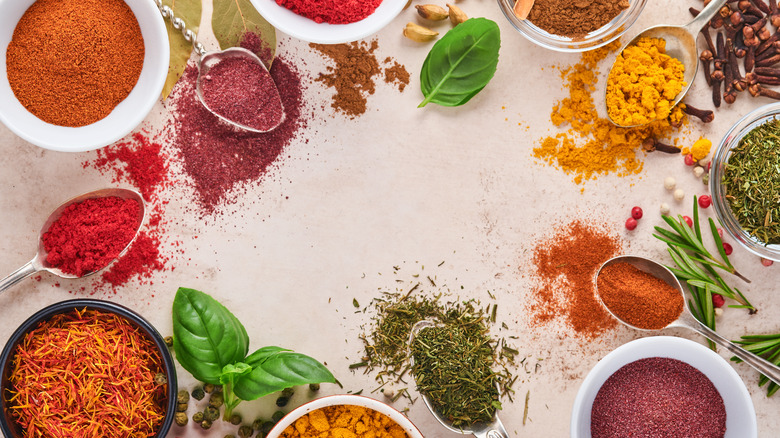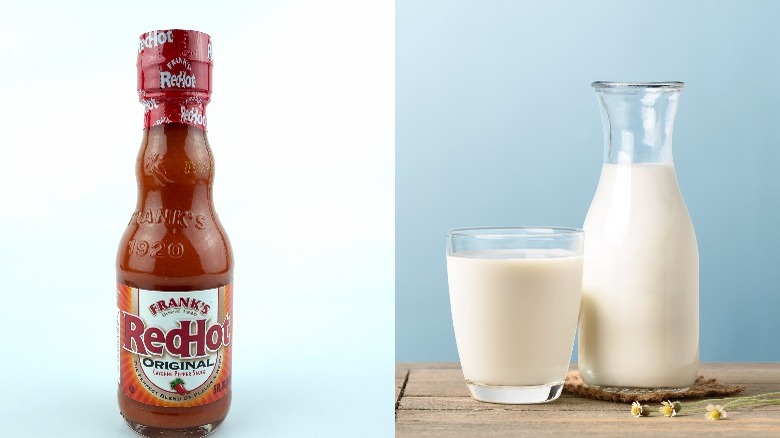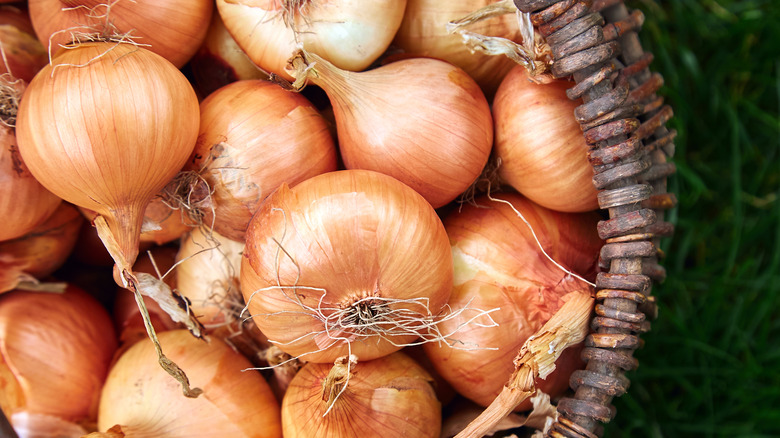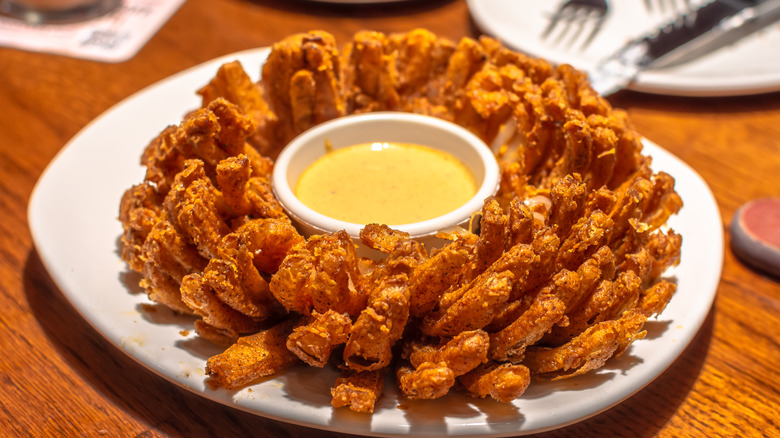This Is What Makes Outback's Bloomin' Onion So Delicious
Outback Steakhouse is familiar to most Americans from their unavoidable TV commercials that usually feature a guy with an Australian accent talking about large slabs of beefs and all sorts of shrimp. Of course, it was founded by a bunch of Americans who had never been to Australia before. And sure, it started in the outback — of a Tampa Bay strip mall.
Despite the glaring lack of authenticity, Americans loved the restaurant's cartoonish Crocodile Dundee vibe, and the chain took off. Top billing, of course, goes to Outback's signature steaks, which are seasoned with a spice mix that's probably more New Orleans than New South Wales. But everyone knows the real star of the menu is the Bloomin' Onion. This flaky flower of fried goodness has been on the menu at Outback since the very beginning, and fans would probably riot if it ever got taken away.
But what tricks do the Outback fry cooks use to make the Bloomin' Onion so much tastier than an average onion ring? Outback is quite protective of its recipes and techniques, but the harsh glow of the internet has shed some light on its secrets. This is how they turn a basic onion into a deep-fried masterpiece.
They're made with super-colossal onions
How do you make a shareable appetizer that can feed four people out of a single onion? You start with an enormous bulb. Specifically, a super colossal onion, which sounds like a phrase a five-year-old would invent, but is actually a term that is used in the onion industry (via The Daily Meal). According to Baldor Food, a super colossal must be at least 4-¼ inches wide at its thickest point. Outback claims that their onions weigh about one pound each after they're prepped and cooked. Since they sell about 14 million a year, that means they go through literal tons of onions.
These aren't just any super colossals, either. Outback partners with 15 farmers across four states who grow exclusively for the chain. That ensures that every onion you order at Outback tastes pretty much the same, regardless of what part of the country (or world) you live in.
A special tool cuts the petals
The Daily Meal reports that when the Bloomin' Onion was introduced, Outback employees had to cut every petal by hand. The chain's menu still says that the Bloomin' Onion is "hand-carved," but that's not really true anymore unless you have a very loose definition of that term. These days, they use a medieval-looking contraption called the Nemco 55700 Easy Flowering Onion Cutter to slice the onions (via The Daily Meal).
First, a cook scoops out the onion's core with a melon baller so the petals separate during cooking. Then they employ the Nemco device to make the perfect petal slices. If you're a true Bloomin' Onion obsessive with $515 to spare, you can actually buy one of these suckers for your home kitchen. You push the onion through the machine with a hand-operated lever, so technically you could say that using the machine counts as "hand-carving." With the volume of this appetizer that Outback sells every night, it makes sense for them to use a machine, as cutting a Bloomin' Onion by hand is difficult and time-consuming.
The concept was perfected for years before it came to Outback
Outback claims on their website that co-founder Tim Gannon invented the Bloomin' Onion in 1988 and that it's a "secret family recipe." While Gannon definitely invented Outback's signature seasoning blend and the Bloomin' sauce that sets their version of this dish apart from the competition, deep-fried onion flowers had been around for years before the first Outback Steakhouse opened (via Mel Magazine).
Gannon freely admits that the first person he ever saw prepare the dish was his friend Jeff Glowski, who at the time was the chef at a restaurant in New Orleans called Russell's Marina Grill. Cooks in New Orleans are masters of the deep-fryer, so it's no wonder that this crunchy delicacy was an instant hit. Ironically, Glowski opened up a New Orleans-style restaurant in Australia where he marketed his onion flower as a Louisiana treat.
By the time Gannon put the Bloomin' Onion on Outback's menu, he had already introduced it to several other restaurants over a period of years. That gave him countless hours of research and development time to produce the perfect appetizer we enjoy at Outback today.
The breading has 17 spices
The breading of a Bloomin' Onion is spiced with Outback's signature seasoning blend. The mix contains 17 spices, and the recipe is a secret. No one else seems to have cracked the code for all 17 spices. Our own Bloomin' Onion homemade recipe has a mere six spices in the breading if you count salt and pepper.
Even the employees don't know what's exactly in the batter, as a self-proclaimed former Outback cook on Reddit wrote that the flour mixture for coating the onion arrived at restaurants pre-mixed. One thing they knew for sure was that the seasoning contained a lot of paprika, which is one of the only spices that most copycat recipes have in common. Another ex-Outback Redditor says that the coating contains cayenne. Both Reddit posts also mentioned that the breading was applied by dipping the onion in seasoned flour, then in an egg wash, then back into the flour. That means that all the recipes use a pre-mixed batter aren't doing it the Outback way.
Bloom sauce has a couple of unexpected ingredients
If you thought 17 spices was a lot for breading, just wait until you get a load of the Bloomin' sauce, which contains a whopping 37 ingredients (via Mel Magazine). Again, the chain keeps these ingredients a secret. One thing that definitely isn't in the sauce, according to this Redditor, is ketchup. Most copycat recipes for the sauce make the mistake of adding a small amount of ketchup to the mix. Rather than tomato, the red-pink color of Bloomin' sauce comes from the hefty does of paprika in Outback's secret seasoning. If this photo of a spice rack from Outback can be trusted, the spice mix has several types of peppercorns in it, as well as ground chile powder and herbs (via Reddit). Bloomin' sauce also has mayo and horseradish in it, which are two details almost everyone gets right.
There are two more curveballs that don't show up in most copycat attempts. The alleged ex-Outback employee on Reddit says that Bloomin' sauce has small amounts of milk and Frank's Red Hot in it. (We never would have guessed the milk!) As for the other secret parts of Outback's seasoning mix, only a few people know the answer, and they're not telling.
All the sugar, salt, and fat make your brain's pleasure centers light up
No one orders a Bloomin' Onion expecting health food, but it's still impressive how much gluttony those fake Australians are able to pack into a simple allium. The Bloomin' Onion contains 1350 calories, over half of what most people need in a day. It also contains about 2.5 times the average daily amount of sodium recommended by the FDA, as well as almost 70% of your daily recommended fat. Shockingly, its 34 grams of sugar is only 5 grams less than a can of Coke (via Coca Cola).
All the sugar, salt, and fat in the Bloomin' Onion can contribute to health problems like high blood pressure and heart disease, but there is an upside: They make it taste really good. Maybe even too good. The News Journal reported on a Yale study that found that fatty, salty, and sweet foods like the Bloomin' Onion act almost like psychoactive drugs, stimulating the parts of your brain that experience pleasure. The researchers hypothesized that the euphoric feelings generated by indulgent food could lead to food addiction.
It's all about the sulfur compounds
Onions are one of nature's most delicious and widely-used foods, and the key to unlocking their potential lies in some interesting chemistry. Food Crumbles explains that onions don't actually taste very oniony when they're whole. A sulfur compound called thiosulfate is responsible for the zesty flavor of raw onions, and that compound is only produced once you cut into the onion and damage its cellular structure. This releases an enzyme called alliinase that reacts with other chemicals in the onion to form thiosulfate. By cutting their onions into petals, Outback initiates this chemical reaction.
A little bit of this sulfur compound is a good thing, but too much can make you cry, especially if you're eating a whole onion. Outback controls the amount of sulfur in their onions in two ways. First, they only use their own special onions. Sulfur levels in onions vary depending on the soil they're grown in, so Outback knows that the onions they buy will have a consistent sulfur content. They also reportedly soak their onions in cold water before breading them (via Reddit). The Kitchn explains that soaking onions after cutting washes away some of the excess sulfur.
It's also all about surface area
Whole onions are great, but they have a problem: a very low surface-area-to-volume ratio. This is an issue for a crispy, fried appetizer, as you want the maximum ratio of crunchy breading to soft, bland interior you can possibly get. The Bloomin' Onion's cutting technique dramatically increases the surface area of the onion, turning a rough sphere into a beautiful blossom with a target of 200 petals. But what makes the breaded exterior of a Bloomin' Onion so tasty (other than the fat and seasoning, of course)? It's a tag team of the miraculous chemical phenomena called the Maillard reaction and caramelization.
The Maillard reaction uses high heat to transform proteins into new and delicious chemical compounds. Caramelization is a similar process, only it works on sugar rather than proteins. The wheat flour in the Bloomin' Onion's breading contains both proteins and sugars, so it benefits from both chemical reactions. Who knew science could taste so amazing?
